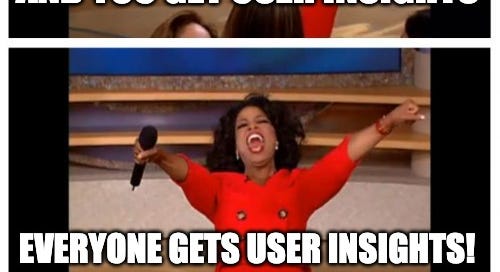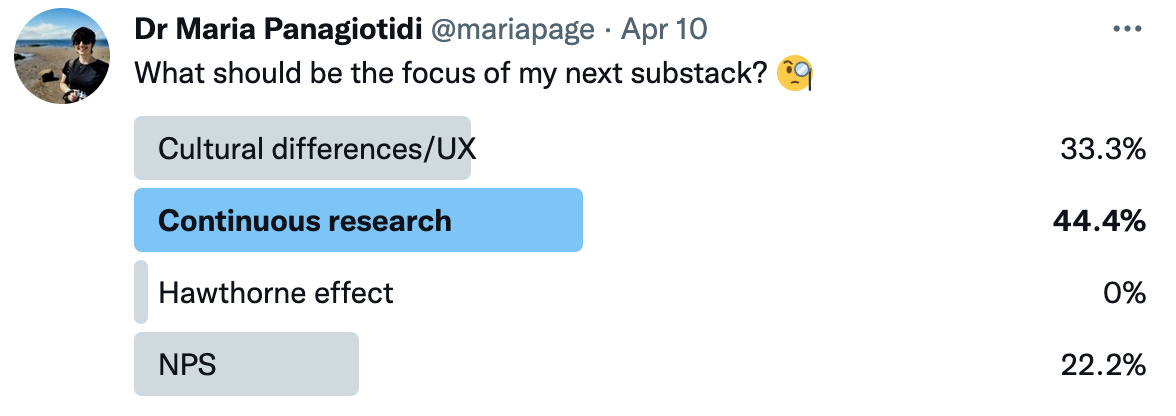From no research to continuous research: a how to guide
My experience as lead UX researcher at a unicorn startup in hyper-growth
A few weeks ago I asked my Twitter followers what my next topic should be. The winner was Continuous research!
In this post, I’ll be talking about my experience introducing continuous research habits at Oyster. Oyster is a unicorn mission-driven start-up that helps companies everywhere hire people anywhere. I joined 6 months ago as a team of one and I’m currently leading UX research.
What is continuous research?
I first came across the idea of continuous user research in Tomer Sharon’s “Continuous user research in 11.6 seconds” post. According to his definition, “continuous research is fast-rhythm research that is open-ended in nature. It’s not dedicated to any specific topic and it’s not research that anyone asks for.”
Coming from academic research I found this idea a bit unusual. Traditionally, researchers conduct dedicated studies in which they try to solve a specific problem or gain a deeper understanding of a particular area. Recruiting users is something that happens once the aims of a study and all the research materials have been created.
Continuous research is a form of proactive research — we constantly schedule user interviews without having a specific project. When we don’t have a focused project, the sessions can be used to help us discover user pain points and uncover opportunity areas. In cases we have specific questions, continuous research allows us to speed up recruitment!
According to Sharon:
“[Dedicated studies] will almost never answer questions you didn’t know you should ask, reveal hidden truths, and help uncover opportunities to innovate.
Another challenge with traditional, dedicated research studies introduces itself when somebody important in the organization suddenly asks, “What do we know about [x]?” If there was no previous dedicated study done on x, there is no answer to the question, and a researcher would go through the lengthy seven-step process described above.”
A similar concept was introduced by Teresa Torres in her book “Continuous Discovery Habits”. According to Torres, Continuous discovery is the process of conducting small research activities through weekly touchpoints with customers, by the team who’s building the product. This could be done by conducting regular interviews with users and getting regular feedback from them (e.g., through surveys).
Continuous research can be qualitative, quantitative, or both. In this post, I’ll be focusing on qualitative research. I’ll be covering quantitative methods in a future post.
Continuous Research at a unicorn startup
Being the sole user researcher in a fast-growing startup can be daunting. One of my main challenges was figuring out a way to enable me and the rest of the team to talk to our users on a regular basis. In previous B2B roles, one of my biggest challenges was recruitment. It wasn’t uncommon to spend weeks trying to find participants and schedule interviews.
One of my first projects was creating a user research panel consisting of internal and external users. A user-research panel is a list or database of potential research participants that you can recruit for specific research activities as they come up. This panel could be used for continuous research and for dedicated projects.
The next step was semi-automating the process. Below is a summary of what we did:
We created an invite to a feedback session appearing to users who have completed certain actions on our platform. The invite was short and sweet (had to try multiple iterations and reviews to find something effective for our users) and included a link to a calendar (Calendly is great for this).
Participants can book a session up to 3 weeks in advance. We decided not to allow them to book too far ahead as this increases the chances of no-shows.
We have dedicated days and hours for user interviews that are always kept meeting-free. If you have international users, it’s important to cover as many timezones as possible.
Participants have to read the information sheet and sign the consent form when signing up for a specific slot. All sessions are anonymous but recorded and the findings are shared with everyone in the company.
We created template emails and reminders to send to the participants upon signing up, a day before, and on the day of the interview.
The agenda for these interviews can be quite open. Sometimes they are driven by the users who want to give specific feedback and others might be focused on a specific topic. I have also created an interview guide and a note-taking excel document shared with the team (if you’re looking for inspiration have a look at this template by User Interviews).
We used Notion to create a shared schedule for the interviews and a sign-up sheet that allows PMs and other stakeholders to observe the sessions they are interested in. We’ve had loads of observers as the team started seeing the value of those sessions. A way to keep observers engaged is by asking them to be note-takers. Having a template that they can use, helps with this.
Follow-up with users: ask users whether we can get in touch with them in the future. In rare cases where a user mentions a problem or has a complaint, we give them the option to connect them to the right team.
Sharing insights: share insights on a weekly basis with relevant teams. Every few weeks we look for common themes and present the insights to the whole company through Slack or asynchronous videos (Loom is great for this).
Evaluation after 3 months…
Since starting talking to our users regularly, we conduct at least 2 interviews per week. As our team grows and more people get involved, the number of sessions will increase. Here’s what we’ve learned so far:
Continuous research can be used to bring the “voice of the user” to the company. Stakeholders have been watching the interview highlight reels and reading the insights before making relevant decisions.
Continuous research doesn’t replace traditional UX research studies. We often have to use traditional recruitment methods if we want to talk to specific personas or segments.
Conducting the sessions and analysing the results can be a time-consuming process. This can be quite challenging if you’re a team of one. We’ve been working on democratising research and enabling other members of the product team to conduct interviews.
Automating parts of the process by using scheduled invites and templates is essential to creating a continuous research habit.
Have you tried a continuous research practice or something similar in your organization? What was your experience?






Hi Dr. Maria! I'm wondering if you'd be open to sharing one of the Loom videos you made to share insights. I'm a team of one at a remote company and am always looking for better ways to share insights from the continuous research I do